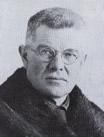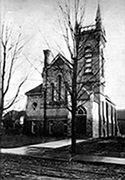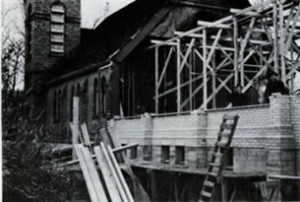The Arrival from Russia
In 1924 a group of Mennonites took the 8,000 mile, three and a half week journey fleeing persecution, torture and death in the Ukraine. This journey began in Russia and ended in August of 1924 at the steps of the Erb St. Mennonite Church. A total of 875 Russian immigrants came off the train that day and were taken in by local Mennonite families.
The Need for Worship

Jacob H. Janzen
Jacob H. Janzen For the rest of 1924, the group of Russian Mennonite immigrants met at Erb St. Mennonite Church and various other churches in the area often worshiping on Sunday afternoons so that they could worship in German. In December of 1924 Rev. Jacob H. Janzen and his family arrived in Waterloo, and began to lead the group who gathered together for worship. It soon became apparent that this group of German speaking immigrants was not going to integrate with the established local Mennonite churches mainly due to the language barrier. The desire quickly arose to begin meeting as a group in a central area, accessible to as many people as possible.
The Mennonite Refugee Congregation in Ontario
On April 18th 1925, 33 people signed a motion in support of organizing a congregation for regular worship. A call was extended at this meeting for J.H. Janzen to lead the congregation. On June 21, 58 people met in a follow up meeting where the motion of April 18th was accepted. At this meeting, there was overwhelming support to continue with the formation and organization of the congregation with Rev. Janzen responsible for leadership. At this meeting it was decided that the newly formed congregation was to be “the Mennonite Refugee congregation of Ontario.
In the six months that followed the congregation grew from 58 to 302, these members were not all residents of the twin cities, as the immigrants from Russia had been scattered around Ontario, living in areas such as New Hamburg, Hespeler, Vineland, Leamington, and Reesor (Northern Ontario). Amazingly Rev. Janzen was minister to all of these communities. Responsible for worship services, baptisms, communion services in the Waterloo church as well as all the satellite churches. As time went by the residents of this area began to integrate into the community landing jobs in the many industries of the region. In August of 1926 the decision was made to change the name to the United Mennonite Church in Ontario – since many of the congregants no longer considered themselves refugees.
The Hall

The worship hall on King Street
The decision was made to rent an old German club on King St. North (now the location of the harmony lunch restaurant). In the first few months worship was held on Sunday afternoon or evening so that the members from Vineland and Leamington could attend and be back for work Monday morning.
Eventually these groups began to worship in their own community. Different churches were founded, but each still carried the distinction of ‘united church’ in their name, recognizing their connection to their sister congregations. A council of elected members from the outlying communities continued to meet in Waterloo to discuss issues of mutual concern and interest for all churches.
According to Herbert Enns, W-K’s late historian, the one thing that the members of the United Mennonite Church had in abundance was poverty! The Hall that was rented by the group was far from ideal since it was used during the week for dances and receptions, but it was all the group could afford at the time. On more than one occasion, volunteers showed up early to clean up the garbage and beer bottles from the night before. Many of the founding church members from this time recall a certain stench that came from behind the curtains at the front of the hall. Try as they might it seemed that the stench could not be removed, but it was least bothersome if the curtains were kept closed.
15 George Street

15 George Street in 1932
Because of the deplorable conditions of the hall, the members quickly began to look for a more permanent building. The search ended when St. Paul’s Presbyterian Church at 15 George St. was made available by the United Church of Canada, which was moving to join the Methodist church at the corner of King and William St (now First United Church). The move from the hall to George St. occurred in October of 1927. Initially the church facility was rented at the reasonable rate of $20 a month, as the United Church recognized the Mennonite’s lack of money. After 5 years of renting the building, in 1932 the Congregation purchased the building for $5000 that sum was later reduced by $1000 as a gift to the congregation. In 1944 twelve years after the purchase, the $4000 debt was finally liquidated.
Plans for Addition
In 1948 the church acquired a piece of property from Dr. C McCarville, directly behind the existing building. Although the property was built with the idea of building a pastor’s residence or to simply have a larger outdoor property, the Council took it upon themselves to inform the membership of the urgent need for more space. The main reason for this extra room was the steady flow of Russian Mennonite immigrants to the area from war-torn Europe following World War II.
In 1949, a vote was held to determine the next steps for addressing this need for space. The results were as follows: to build a completely new building, 117 ballots; for add a balcony to the existing sanctuary, 45 ballots; for an addition to the back of the church, 29 ballots. Because the majority favored a new structure, a committee began to look for a suitable location for this new church building. A plot of land was found and purchased near King and Hickory streets in Waterloo. Unfortunately, a combination of fear of not selling the George St. property, and not raising enough money within the membership led to another vote, to test the willingness of the congregation to undergo such a large project. The results of this vote were: to continue with the building of the new church, 29 votes; the build an addition to the existing church, 135 votes.
With a clear mandate from the congregation, council began to plan an addition to the back of the sanctuary. While there were many obstacles, as with any major undertaking such as plans, building permits, and cash flow; the largest obstacle was moving the organ. As the new addition was being build out the back behind the location of the existing organ, the organ had to be dismantled, so that the back wall could be removed, then relocated some 40 ft further back, and reassembled. As many know it is easier to take apart something apart than it is to build it, the load of this rebuilding task was completed by Henry Janzen.
The Building Begins

The addition to the back of the sanctuary
On October 20, 1951 building began on the project to double the size of the sanctuary. As the building continued through the winter, new questions began to arise pertaining to the colour of the glass on the windows, and the need for new pews. Since it was deemed to be too difficult to replicate the windows, they were replaced with new yellow and blue stained glass. The old windows were given to the First United congregation, to be used in the construction of Knox Presbyterian church in 1957.

The new windows
The next problem was seating. The layout of the old sanctuary had two small aisles which many of the members deemed to not be practical. The layout was to be changed to one wider centre aisle, but with this new layout, new pews needed to be purchased. In September of 1952 40 new pews were purchased from the Globe Furniture Company in Waterloo for $4,277.00.
On March 1, 1953 the new building was officially dedicated. As the congregation settled into its new surroundings, a deep feeling of gratitude was in evidence in all levels. There were new, bright Sunday School classrooms, the sanctuary was large and inviting, the minister enjoyed an office, for the first time, in the back corner of the church.
Changing Language
At the annual meeting of 1955, a motion was brought forward proposing 2 English services a month. This motion was amended to 1 English service a month and then passed. With the influx of many immigrants to Canada, and the increase of membership at W-K, many of whom counted German as their first language, and knew little English, the gradual transfer from the German language to English in worship services had been halted.
The need for the English language, was nevertheless pressing, especially in Sunday School teaching. Despite these concerns many members still believed that German had to be maintained at all branches of the church’s operations. In 1959 church council made a motion recommending a trial period of alternating English and German each Sunday. In late 1959 yet another proposal was made to make the 1st, 3rd. and 5th Sundays of every month German in the worship services with an evening English service. On the 2nd and 4th Sundays the morning worship would be in English with an evening service in German. Due to a lack of participation, the evening services were soon discontinued. In 1966, after a survey of the membership, the proposal was made to replace the single Sunday morning service with two worship services – one English one German.
Moving Ahead
In 1960 the relatively harmless question was raised at the annual meeting about improving the front entrance of the church. This was a much needed departure from the small dimly lit front entrance that was used up until then. By March of 1960 the congregation accepted a motion to build a ‘vestibule’ in front of the sanctuary. The vestibule included: an outside canopy over the front door, a cross on the outside wall, a planter, and a kitchen below the vestibule. This project was completed for $28,674.00.
Other events that required the consideration of the members in the 60’s were: increasing the size of the parking lot, hiring a secretary to assist the pastor, the appointment of money counters, and participation in the proposed construction of a Mennonite College – Conrad Grebel College – on the campus at the University of Waterloo.
The Education Wing
As the congregation continued to grow, the decision to build an “education wing” including offices, classrooms, a lounge a new kitchen, and a gymnasium was approved on March 17, 1974 at a total cost of $264,000.00.
The bulk of this information is indebted to the historical work of the late Herbert Enns, W-K Church Historian. Excerpts of this account were taken primarily from the WKUM Jubilee Edition 1924-1974
